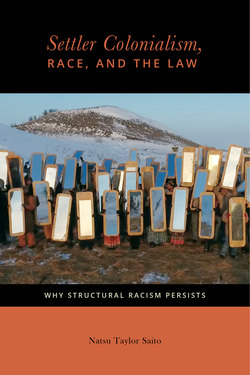Читать книгу Settler Colonialism, Race, and the Law - Natsu Taylor Saito - Страница 36
На сайте Литреса книга снята с продажи.
Indirect Killing, or Disease
ОглавлениеThe Angloamerican settlers’ presumption of a sovereign prerogative to occupy the land, with its corollary requirement of eliminating its Indigenous residents, is manifest in many ways that go beyond direct killing. In the dominant narrative, the “vanishing” of American Indians is attributed primarily to diseases unwittingly transmitted by European colonists. Certainly Indigenous peoples of North America and the Hawaiian Islands were decimated by the introduction of a wide variety of diseases, including typhoid, measles, influenza, syphilis, tuberculosis, and, perhaps most notoriously, smallpox.43 While some of the epidemics that ensued upon the arrival of European invaders may not have been intentionally induced, the colonizers were well aware that these diseases were rampant in Europe, that they were infectious, and that their crews were often ill when they arrived.44
We also know that in numerous instances disease was deliberately introduced into Native populations, and that long before some of the most virulent smallpox epidemics, the settlers possessed and utilized vaccines that were denied to Indigenous peoples.45 Thus, regardless of the percentage of disease-related deaths attributable to settler intent, it is clear that what was in essence biological warfare was utilized to “clear” the land of peoples who, by staying home, were hindering settler expansion.46 Perhaps most notoriously, in 1763 Lord Jeffrey Amherst, commander-in-chief of the British colonial forces, instructed his subordinates to infect “the Indians by means of blankets as well as to try every other method that can serve to extirpate” them, a task his men duly reported to have accomplished.47 In 1775 Iroquoian delegates to a treaty negotiation were given disease-infested “gifts” by their hosts, and in 1837 government agents distributed smallpox-infected blankets to the Mandan and other peoples in North Dakota and then advised those who had been infected to seek refuge among their healthy relatives.48 The resulting pandemic in the Upper Missouri and the Plains is estimated to have killed at least 100,000 people.49
Deaths attributed to other “natural” causes were the commonplace, predictable, and often intended consequence of colonial practices and policies. The massacres and epidemics described above, as well as the settlers’ routine destruction of housing and crops, were inevitably followed by famines and death from exposure. Fifty percent mortality rates were common—and therefore, quite predictable—in conjunction with the forced removals and internments discussed below, as well as in the boarding schools American Indian children were compelled to attend.50 The deliberate subjection of peoples to these conditions, with full awareness of their consequences, constitutes the imposition of “slow death measures,” described in the Genocide Convention as “deliberately inflicting on the group conditions of life calculated to bring about its physical destruction in whole or in part.”51
These are not concerns that can be relegated to the past. The Centers for Disease Control and Prevention (CDC) report that between 1999 and 2009 the overall death rates of American Indians and Alaska Natives, men and women, were nearly 50 percent greater than those of White Americans.52 Native people are twice as likely as the general population to have diabetes, almost eight times as likely to contract tuberculosis, and at significantly higher risk for asthma, chronic liver disease, heart disease, and stroke.53 In 2014 suicide was the second leading cause of death for American Indian/Alaska Natives aged ten to thirty-four, and the leading cause among girls aged ten to fourteen.54
